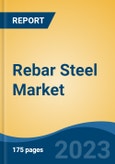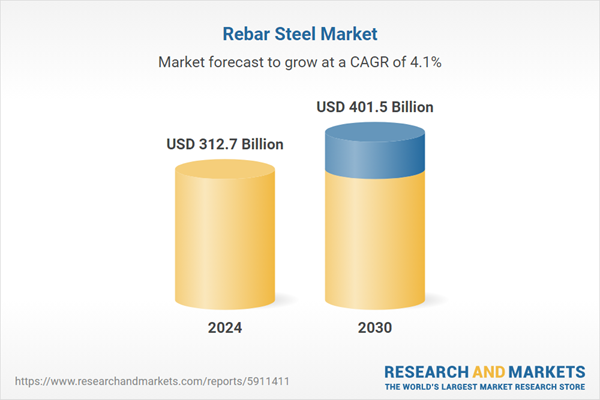Speak directly to the analyst to clarify any post sales queries you may have.
10% Free customizationThis report comes with 10% free customization, enabling you to add data that meets your specific business needs.
Additionally, the adoption of advanced manufacturing technologies, including thermomechanical treatment (TMT) and electric arc furnaces (EAF), is enhancing product quality and efficiency, making high-strength and corrosion-resistant rebar more accessible. Sustainability trends are also reshaping the market, as steel producers invest in low-carbon and recycled steel to meet global climate targets. Furthermore, policy support in the form of infrastructure stimulus packages in regions like North America, Europe, and Asia-Pacific continues to act as a strong growth catalyst. The increasing popularity of earthquake-resistant and fireproof construction further adds to the market’s momentum. Overall, a combination of technological innovation, government funding, and environmental awareness is steering the global rebar steel market toward consistent growth over the coming years.
Key Market Drivers
Surge in Infrastructure Development and Urbanization
One of the most significant drivers of the global rebar steel market is the growing demand for infrastructure development, fueled by rapid urbanization. As cities expand and populations rise, the need for robust and long-lasting infrastructure becomes imperative. Rebar steel, used extensively in concrete reinforcement, plays a critical role in the construction of roads, bridges, airports, tunnels, railways, and buildings. Developing nations such as India, China, Indonesia, Vietnam, and Brazil are investing heavily in infrastructure to support their growing populations and economic ambitions. Simultaneously, developed regions like North America and Europe are focused on upgrading aging infrastructure, which also demands high volumes of reinforced steel.Government-backed infrastructure initiatives, such as India’s Smart Cities Mission, China’s Belt and Road Initiative (BRI), and the U.S. Infrastructure Investment and Jobs Act, are providing consistent momentum to the rebar steel industry. Additionally, megaprojects in the Middle East, including NEOM in Saudi Arabia and extensive airport and highway expansions in the UAE and Qatar, further accelerate demand. These projects require premium-grade rebar for safety, longevity, and earthquake resistance.
As urbanization increases, especially in Asia and Africa, more residential and commercial buildings are being constructed. This, combined with increasing middle-class income levels and housing affordability schemes, fuels the consumption of rebar. Moreover, rebar is often required to meet stringent building codes and safety regulations, especially in seismic-prone zones, reinforcing its importance. As global governments continue to channel large-scale investments into infrastructure modernization and urban expansion, the rebar steel market is expected to see sustained growth, particularly in emerging economies.
The long-term nature of infrastructure projects ensures a stable demand curve, making this a foundational driver for the market’s positive outlook over the next decade. Over 55% of the world’s population lives in urban areas, projected to rise to nearly 70% by 2050. Global infrastructure investment needs are estimated to exceed 90 trillion US dollars by 2040. The construction industry contributes around 13% of global GDP. Urban infrastructure spending has been increasing at a rate of 5 to 7% annually in recent years. Emerging markets account for more than 60 percent of global infrastructure growth. Over 1 billion people are expected to move to urban areas over the next two decades, increasing demand for transport, housing, and utilities.
Key Market Challenges
Raw Material Price Volatility and Supply Chain Disruptions
One of the primary challenges facing the global rebar steel market is the volatility in raw material prices, particularly iron ore, scrap metal, and coking coal. These materials are fundamental inputs in steel production, and their prices are highly influenced by global demand-supply dynamics, geopolitical tensions, and environmental policies. Fluctuations in these costs directly impact the pricing structure of rebar steel, creating uncertainty for manufacturers and construction companies alike.For example, during the COVID-19 pandemic and the Russia-Ukraine war, global supply chains experienced severe disruptions. Many steel-producing regions faced shutdowns, and freight rates surged due to logistics bottlenecks. The ripple effects caused delays in rebar shipments and significantly increased costs. Smaller players, especially in developing markets, struggled to remain competitive amid these rising input costs. Additionally, protectionist trade policies like anti-dumping duties and import tariffs - common in the U.S., China, and the EU - further complicate cross-border sourcing of steel materials.
Moreover, environmental regulations are tightening globally. Many countries now require cleaner production processes, pushing companies to shift from traditional blast furnaces to more sustainable but cost-intensive alternatives like electric arc furnaces (EAFs). While this is a positive long-term shift, it increases capital expenditure in the short term. Manufacturers that fail to adapt may face operational challenges or become non-compliant with evolving standards.
Key Market Trends
Rising Adoption of Thermo-Mechanically Treated (TMT) Rebars
One of the most significant trends in the global rebar steel market is the increasing use of Thermo-Mechanically Treated (TMT) rebars over conventional rebars. TMT rebars offer superior strength, better weldability, and enhanced corrosion and earthquake resistance, making them the preferred choice for modern infrastructure and construction projects. As urbanization accelerates and building codes become more stringent - particularly in seismic-prone and coastal regions - TMT rebars are becoming a structural necessity rather than an option.In addition to mechanical advantages, TMT rebars are also more cost-effective over the life cycle of a structure. Their corrosion resistance reduces long-term maintenance costs, and their flexibility allows for complex architectural designs. Many governments and construction authorities across countries like India, China, and the UAE have begun mandating the use of TMT bars for large-scale projects such as metro systems, high-rise buildings, and highway bridges.
This trend is also gaining traction in developed markets such as North America and Europe, where the focus is on upgrading aging infrastructure with safer, more durable materials. The popularity of TMT rebars has encouraged steel manufacturers to invest in advanced rolling mills and quenching technologies to meet rising demand and quality expectations.
Moreover, the rise of eco-friendly construction practices has contributed to TMT’s growth. Since TMT rebars consume less steel for the same strength output, they align well with sustainability goals. As environmental consciousness increases globally, the demand for energy-efficient and low-carbon construction materials like TMT rebars is expected to surge. Overall, the shift toward TMT rebars is reshaping product offerings, manufacturing technologies, and customer preferences, making it a key market-defining trend over the next decade.
Key Market Players
- ArcelorMittal S.A.
- Nippon Steel Corporation
- Tata Steel Limited
- JSW Steel Limited
- POSCO Holdings Inc.
- Gerdau S.A.
- China Baowu Steel Group Corporation Limited
- Hyundai Steel Company
Report Scope:
In this report, the Global Rebar Steel Market has been segmented into the following categories, in addition to the industry trends which have also been detailed below:Rebar Steel Market, By Type:
- Deformed
- Mild
Rebar Steel Market, By Application:
- Residential
- Commercial
- Industrial
- Public
Rebar Steel Market, By Process:
- Basic Oxygen Steelmaking
- Electric Arc Furnace
Rebar Steel Market, By Region:
- North America
- United States
- Canada
- Mexico
- Europe
- Germany
- France
- United Kingdom
- Italy
- Spain
- Asia Pacific
- China
- India
- Japan
- South Korea
- Australia
- South America
- Brazil
- Colombia
- Argentina
- Middle East & Africa
- Saudi Arabia
- UAE
- South Africa
Competitive Landscape
Company Profiles: Detailed analysis of the major companies present in the Global Rebar Steel Market.Available Customizations:
With the given market data, the publisher offers customizations according to a company's specific needs. The following customization options are available for the report.Company Information
- Detailed analysis and profiling of additional market players (up to five).
This product will be delivered within 1-3 business days.
Table of Contents
Companies Mentioned
- ArcelorMittal S.A.
- Nippon Steel Corporation
- Tata Steel Limited
- JSW Steel Limited
- POSCO Holdings Inc.
- Gerdau S.A.
- China Baowu Steel Group Corporation Limited
- Hyundai Steel Company
Table Information
| Report Attribute | Details |
|---|---|
| No. of Pages | 188 |
| Published | July 2025 |
| Forecast Period | 2024 - 2030 |
| Estimated Market Value ( USD | $ 312.7 Billion |
| Forecasted Market Value ( USD | $ 401.5 Billion |
| Compound Annual Growth Rate | 4.1% |
| Regions Covered | Global |
| No. of Companies Mentioned | 8 |









